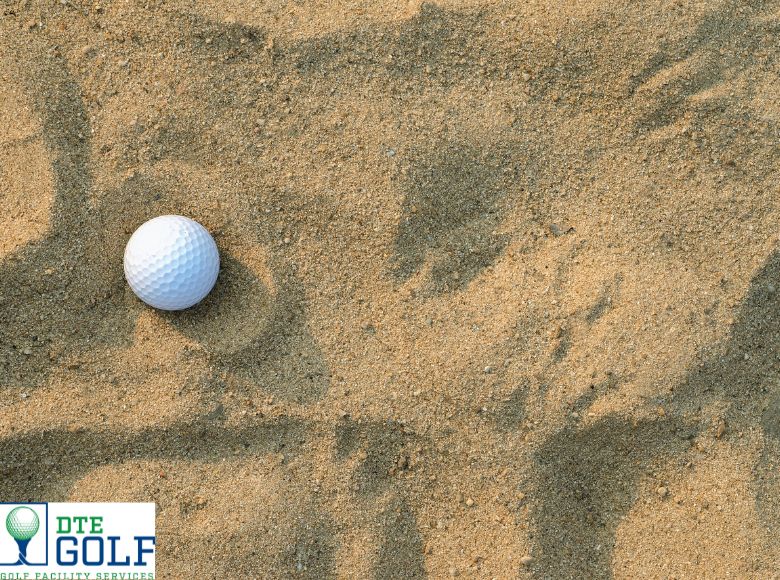Golf course sand is essential for shaping firm, playable surfaces specially when it comes to the Florida course maintenance plan. It supports turf health by improving drainage, preventing waterlogging in high-traffic areas. Choosing the right golf course sand blend can reduce erosion and support consistent ball roll across the fairways and greens.
Different golf course sand types influence playability and turf resilience. Coarser sand allows quick drainage, while finer particles create a smooth putting surface. Understanding the local climate and soil conditions helps select the best golf course sand for each section of the course.
Effective sand management is a key practice in long-term maintenance. Sand management helps distribute topdressing evenly and refreshes bunker sand. Proper sand management keeps playing surfaces safe for golfers and limits turf damage.

Golf Course Sand Types Overview
Here are common golf course sand types used in Florida course maintenance, with their benefits and uses:
- Silica Sand: High purity silica sand promotes fast drainage and resists compaction. It stays stable under heavy play and supports consistent turf growth. The grains are angular, which helps them stay in place even under frequent raking or foot traffic. This type of sand also reduces the chances of ball plugging, making bunker play more predictable.
- Mason Sand: With medium grain size, mason sand offers a balance of drainage and firmness. It is ideal for bunker faces and transition zones. Its texture provides a firm surface that resists shifting but remains playable. Mason sand also blends well with other materials, helping maintain bunker structure over time.
- Pit Sand: Coarser pit sand layers improve sub-surface drainage and reduce waterlogging. It helps keep root zones aerated. The larger grains allow water to pass quickly, preventing puddles and soggy areas. This also supports healthier turf in surrounding areas by reducing water retention.
- Manufactured Sand: Crushed stone sand provides uniform particle size and offers predictable play characteristics. It is durable under heavy cart traffic. Its stability keeps bunker shapes consistent, even after storms or high use. Manufactured sand is often selected for long-term performance and reduced maintenance needs.
These golf course sand types vary in texture and performance. Selecting the right blend supports efficient golf maintenance and extends the life of turf areas. DTE Golf® offers expert guidance on selecting golf course sand types for optimal drainage and playability.
How Sand Management Supports Turf and Course Health
Proper sand management strengthens turf by maintaining surface consistency and nutrient balance. Sand aids in air exchange and moisture control at the root level. Regular topdressing with quality sand prevents thatch buildup and promotes deeper root systems.
Sand management also protects fragile greens by adding a thin layer that smooths imperfections. This practice reduces wear on mowing equipment and supports uniform ball roll. Golf maintenance teams rely on sand topdressing as a core part of their seasonal care routines.
Selecting golf course sand blends that match local turf species and soil types improves overall performance. Working with a sand specialist ensures that particle size distribution meets design specifications for fairways, greens, and bunkers.
Selecting Golf Course Sand Types for Specific Areas
Golf course sand selection can be fine-tuned for each area of the course. Different zones require tailored approaches:
- Bunker Floors: Use finer sand for a smooth surface that holds rake lines. It offers consistent ball lies and prevents deep divots.
- Green Topdressing: Apply ultra-fine sand to fill small surface voids, promote smooth putting, and enhance turf health.
- Fairway Transitions: Choose medium-grade sand to protect the root zone and improve drainage in high-traffic corridors.
- Subsurface Layers: Install coarser sand under greens and tees to speed water movement and avoid root-zone saturation.
Customizing the blend for each area supports both golf maintenance and golf management goals. Sand management in these zones reduces turf stress and improves playing conditions.
DTE Golf® can evaluate your course zones and recommend the best sand types for each area.
Comparing Golf Course Sand Types and Drainage Performance
Golf course sand varieties differ in how fast they drain water and how stable they remain under use:
- Drainage Rate: Coarse sands drain rapidly, protecting turf from waterlogging. Fine sands hold moisture longer, aiding in dry spells.
- Particle Shape: Round grains resist compaction, while angular grains interlock to form firm surfaces.
- Mineral Composition: High-purity sands resist breakdown and reduce dust.
- Cost and Availability: Locally sourced sands lower transport costs and ensure consistent supply.
Understanding these factors allows course managers to match sand characteristics with maintenance budgets and performance goals. Effective sand management balances drainage needs with surface stability.
Long-Term Advantages of Proper Sand Management
Proper sand management creates a solid foundation for course longevity. It prevents erosion, reduces turf repair costs, and enhances playability. A well-informed sand strategy aligns with both golf maintenance and golf management objectives.
Regular sand topdressing supports turf recovery after stress events like heavy rains or frost. Consistent sand management keeps greens true and fairways firm, leading to a better golfer experience.
Integrating sand maintenance into your annual care plan ensures that all course areas receive tailored attention. This proactive approach saves time and resources, delivering long-term value for course owners.
DTE Golf® provides ongoing sand management services to help courses maintain peak performance year-round.
DTE Golf® Sand Management Services
Here are the sand-related services offered by DTE Golf®:
- Sand Type Consultation: Expert analysis to choose the right golf course sand for each area.
- Topdressing Application: Precise sand placement to smooth surfaces and improve drainage.
- Bunker Renovation and Sand Replacement: Removing old sand and installing new, high-quality sand blends.
- Subsurface Sand Installation: Layering coarse sand beneath root zones for optimal water flow.
- Sand Management Audits: Regular reviews to adjust sand strategies based on performance data.
For reliable sand management solutions that support turf health and playability, contact DTE Golf® today.
